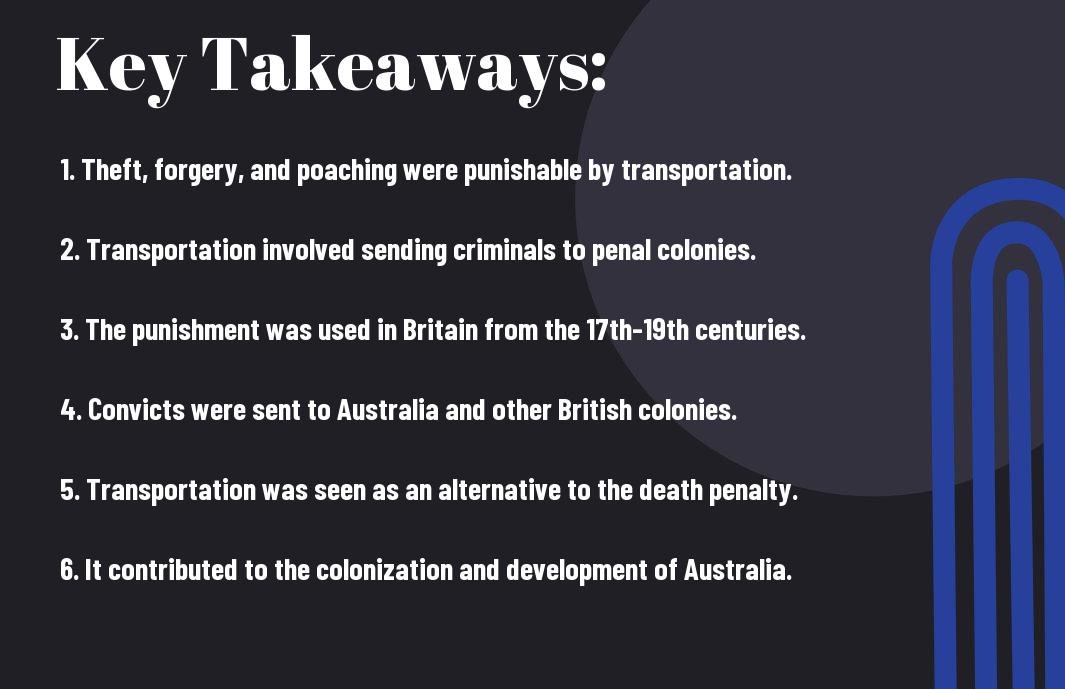Delve into the intriguing world of 18th and 19th century legal system and uncover the 19 crimes punishable by transportation. This form of punishment was commonly used in Britain and its colonies, from the late 18th century until the mid-19th century. While many may be familiar with the idea of transportation as a punishment, the specific crimes that could result in this fate are often not widely known. In this blog post, I will explore the severe consequences of committing these crimes and the impact they had on individuals and society at large.
Key Takeaways:
- Transportation as Punishment: Transportation was a common legal punishment in 18th and 19th century England, where individuals convicted of certain crimes were sent to penal colonies in Australia.
- 19 Crimes: The 19 crimes punishable by transportation included offenses such as theft, burglary, forgery, and poaching, as well as more serious crimes like murder and treason.
- Severity of Punishment: Transportation was seen as a harsh punishment, as it involved permanent exile from one’s home country and forced labor in distant colonies for a set period of time.
- Social Impact: The practice of transportation had a significant impact on British society, as it led to the establishment of penal colonies in Australia and the forced migration of thousands of individuals, contributing to the settlement of the continent.
- End of Transportation: The use of transportation as a punishment gradually declined in the 19th century and was officially abolished in 1857, as other penal measures and prison reform efforts gained prominence.
The 19 Crimes Punishable by Transportation
To understand the historical legal punishments in the 18th and 19th centuries, it is important to recognize the 19 crimes punishable by transportation. During this time, individuals found guilty of certain offenses were sentenced to penal transportation, which involved being exiled to penal colonies in Australia. This punishment was considered a form of long-term imprisonment, with convicts typically serving a sentence of seven years or more. The crimes that warranted transportation were diverse and reflected the social and economic challenges of the time.
Theft and Larceny
One of the crimes punishable by transportation was theft and larceny, which involved unlawfully taking someone else’s property with the intention of permanently depriving them of it. This offense was viewed as a severe breach of societal trust and was punishable by being sent to a distant penal colony.
Forgery and Counterfeiting
Forgery and counterfeiting were also among the crimes punishable by transportation. These offenses threatened the stability of the economy and were met with strict consequences, including exile to penal colonies.
Highway Robbery
Highway robbery, which involved stealing from travelers or merchants on the road, was a serious crime punishable by transportation. It posed a significant threat to public safety and commerce, leading to harsh penalties for those convicted.
Poaching and Illegal Hunting
The unauthorized hunting or poaching of game was another offense that could lead to transportation. These activities were seen as undermining the rights of landowners and jeopardizing the local ecosystem.
Burglary and Breaking and Entering
Burglary and breaking and entering, which involved unlawfully entering a building with the intent to commit a crime, were punishable by transportation. These acts of trespass and theft were deemed serious violations of property rights.
Arson
Arson, the deliberate act of setting fire to property, was considered a heinous crime that could result in transportation. The destructive nature of arson posed a significant threat to communities and warranted severe consequences.
Assault and Battery
Acts of assault and battery, which involved causing physical harm to others, were also among the crimes punishable by transportation. These violent offenses were viewed as a danger to public safety and societal order.
Treason
Treason, or betraying one’s country or allegiance, was perhaps the most serious crime punishable by transportation. It was seen as a threat to the stability and security of the nation, leading to exile as a severe punishment.
Smuggling
Now, let’s discuss another one of the 19 crimes punishable by transportation: smuggling. Smuggling was a serious offense during the 18th and 19th centuries, as it involved the illegal transportation and trade of goods, often without paying the required taxes or duties. This crime was particularly prevalent in coastal areas and along the borders, where individuals would attempt to evade the authorities and profit from their illicit activities.
Rebellion
Rebellion was another crime that could lead to transportation. Engaging in acts of rebellion against the government or challenging the authority of the ruling powers was considered a threat to the stability of society. Those found guilty of rebellion could face transportation as a means of removing them from the country and preventing further agitation and unrest.
The Transportation Punishment
After being found guilty of one of the 19 crimes punishable by transportation, you would typically be sentenced to transportation for a term of 7, 14 years, or life, depending on the severity of your crime. This punishment involved being forcibly removed from your home country and sent to one of the British colonies, primarily Australia, to serve out your sentence. This practice was carried out from the early 17th century until the mid-19th century as a way to alleviate overcrowding in British prisons and to establish labor in the colonies.
The Journey to Australia
Once sentenced to transportation, you would embark on a perilous journey to Australia, which could last several months. The conditions on these ships were deplorable, with overcrowding, poor sanitation, and inadequate food and water. Many prisoners did not survive the journey, succumbing to disease, malnutrition, and harsh treatment from the crew. Nevertheless, those who did survive were met with the daunting prospect of being sent to a foreign land to serve out their sentences.
Living and Working Conditions
Upon arrival in Australia, prisoners faced grueling living and working conditions. They were typically assigned to labor gangs, working long hours in harsh environments such as mines, farms, and construction sites. The living conditions were harsh, with minimal shelter and poor rations. While some prisoners were able to eventually secure their freedom and establish themselves in Australian society, many lived out their days in difficult circumstances.
Emancipation and Pardons
For some prisoners, the potential for emancipation or a pardon was the only glimmer of hope on the horizon. Over time, the Australian colonies implemented systems for early release and pardons, allowing some prisoners to regain their freedom and re-establish themselves in the community. However, the process was often fraught with challenges and required individuals to demonstrate good behavior and a commitment to building a new life.
Legacy and Impact
Not only did the transportation system have a significant impact on the lives of those who were sentenced, but it also had long-lasting effects on the colonies to which the convicts were sent. The legacy of this form of punishment can still be seen in modern-day Australia and America.
Impact on Convicts
The legacy of transportation can still be felt by the descendants of the convicts who were sent away. Many families in Australia and America can trace their roots back to these transported individuals. Being forcibly removed from their homes and sent to a distant land had a profound impact on their lives. It resulted in the loss of their freedom and the disruption of their social and familial ties.
Impact on Colonies
The influx of convicts from England had a significant impact on the colonies of Australia and America. The presence of these individuals contributed to the development of these nations in various ways. The labor provided by the convicts was instrumental in building infrastructure, including roads, bridges, and buildings. Additionally, the skills and trades that the convicts possessed also contributed to the growth and development of these colonies.
Legacy in Modern Times
The legacy of transportation is still visible in the demographic makeup of modern Australia and America. Many families can trace their lineage back to individuals who were transported as convicts. There are also cultural and historical reminders of this period, which serve as a testament to the enduring impact of this form of punishment.
Not only did transportation leave a lasting impact on the lives of the individuals who were punished, but it also played a crucial role in the development of the colonies to which they were sent. The legacy of this system is still evident in modern society, serving as a reminder of the harsh and often unjust punishments that were once employed in the legal system.

Conclusion
Presently, we have explored the historical legal punishments known as transportation and the 19 crimes that were punishable by this method. We have learned that these crimes ranged from theft to forgery and were punishable by exile to the Australian colonies. By understanding the severity of these punishments, we gain insight into the justice system of the time and how society dealt with criminal behavior. It is important to recognize the impact of such punishments on individuals and the broader social dynamics of the era. As we reflect on these historical practices, we are reminded of the evolution of legal and penal systems and the strides that have been made to promote more humane and just forms of punishment.
FAQ
Q: What were the 19 crimes punishable by transportation?
A: The 19 crimes punishable by transportation were a set of offenses that, if committed, could result in being sentenced to transportation to a penal colony in Australia. These crimes included theft, poaching, forgery, and other offenses against property and persons.
Q: When did the punishment of transportation occur?
A: The punishment of transportation was primarily used in the 18th and 19th centuries, with the practice starting in the early 1600s and gradually coming to an end in the 1850s.
Q: Why was transportation used as a punishment?
A: Transportation was used as a punishment for several reasons. It was seen as a way to alleviate overcrowding in British prisons, while also serving as a deterrent for potential criminals. Additionally, it was a way for the British government to populate and develop its colonies in Australia.
Q: What were the conditions like for those who were transported to Australia?
A: The conditions for those who were transported to Australia were harsh. Many convicts faced grueling labor, poor living conditions, and limited freedoms. However, some were able to eventually earn their freedom and establish new lives in Australia.
Q: How did the practice of transportation come to an end?
A: The practice of transportation to Australia gradually came to an end as the British government sought other methods of punishment and as public opinion shifted against the practice. The last transportees arrived in Western Australia in 1868, marking the end of this form of punishment.




